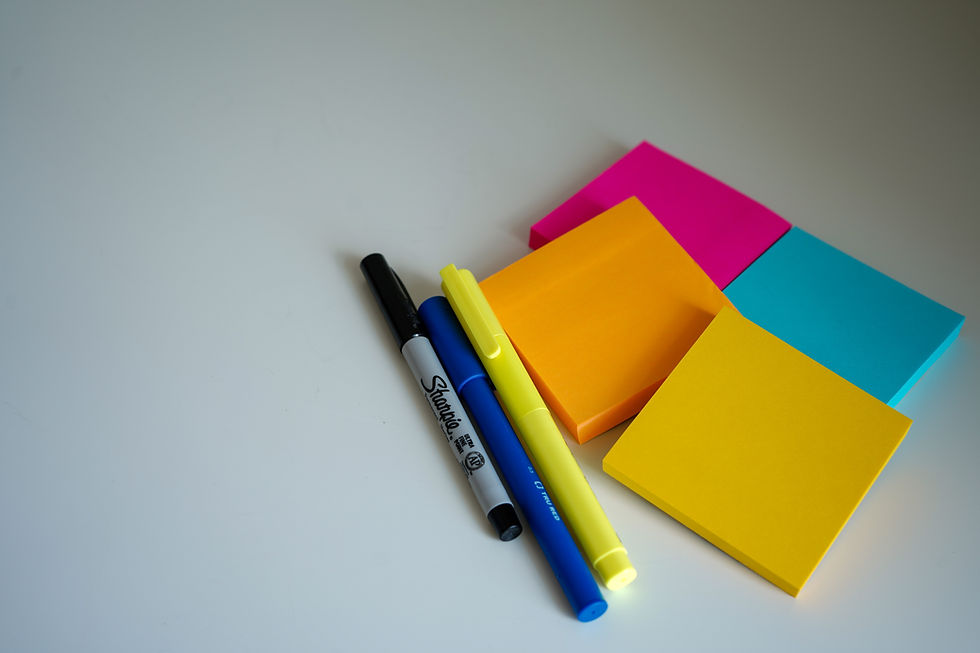The impact of space on the working process and creativity
- Livia Santos Germano

- Oct 26, 2021
- 4 min read
The space where we work has a great influence on the process and result of the work itself. It has a direct impact on us! So, how to prepare the workspace for creative collaboration?
Consciously or not, we internalize and replicate what the workspace “tells us” about how to work. The arrangement of chairs, tables - or the lack of them! -, the walls, the amplitude of the room, zoning of the teams, separations or integrations of areas, the colors, textures, luminosity, in short...everything and every aspect sends a message, a code, which as a whole gives us clues about the way of being and doing in that place.
Productivity, performance and volume
Most workspaces were developed from the industrial logic - serial, mechanized, standardized - in which a fixed structure served to provide a single work base, to achieve certain results.
Just look at the classrooms, with their desks lined up and focused on the blackboard, so that students can absorb the greatest possible volume of information, with the teacher as a great centrality, but placed in this space in a distant and inaccessible way to the students. students, from the configuration of chairs, board and table of the teacher, almost an authority in the harshest sense of the word - and remember, you can't talk, exchange with the friend sitting next to you!
We see this logic and configuration also in the meeting rooms of large companies, especially in more traditional cultures, where the boss, the great leader, sits at the end of the table, a prominent and powerful place, from where he dominates the conduct of the meeting. , generally counting on little participation and contribution from the other participants. That same, that space emits a very strong behavioral code.

In my experience as a teacher and facilitator of creation and innovation processes, I can see how much space impacts behavior and the way people interact and create. Space can provoke, instigate ways of relating, it can inspire and stimulate people to create, it all depends on how open, flexible and adaptable it is.
Sealed or standardized, serial structures hardly invite participants to interact with each other, much less with the space itself. Everything that is standardized does not inspire.
Reconfiguring relationships with the physical space can be a powerful signal that participants, whether in a meeting, workshop or sprint, are truly welcome in that space and that there is indeed the freedom to express and create. There is no single format for building collaborative spaces, a single one that can unleash this creative potential. The people who work there must be encouraged to transform and adapt, moving things, objects or furniture around, in order to function better based on the nature of the work that is performed there. This interaction with the space must be thought out and done together with those who will interact and work there.
Open, adaptable and inspiring
In 2015 I had the opportunity to visit Ideo and the D. School in Silicon Valley in San Francisco and I can say that I saw this concept of Make Space for Change in practice and how the space where people work as a team or individually can play an important role in the creation process and strategy.
Modularity, movable walls, mood boards and inspirational panels, adaptable furniture, integrated work tables, individual tables, spaces for reflection, rest and inspiration… in addition to keeping materials and work tools available, which stimulate and strengthen different skills, from the most manual to the most intellectual and analytical.
If you look carefully at your desk, it will certainly say a lot about the way you work, and can act as an instrument of creative stimulation.
Space as a facilitation tool for co-creation
In my work as a facilitator of co-creation processes, I consider the space where the workshop will take place an element that has a greater role than is usually thought. Whether in physical space or online - that last object of conversation from another post! - plan the way in which the workflow will take place, the interactions between people during the dynamics, the tools to be used - post its, paper, cards , games etc - and the stimuli that will be offered is crucial to achieve the desired goals with this team meeting.
If we arrange the chairs and tables in a row, as in a classroom, for example, we create a feeling that that forum will have a central interlocutor; if we configure the room with the chairs in a “U” shape, we create the sense that there is an intention to promote conversations in which everyone has a voice and a voice; the shape of the table also says a lot about the intentions. A round table creates an atmosphere that everyone seated there is equal and that the conversation is more fluid, without corners or edges. The conversation flows round ;). A traditional rectangular meeting table with headboards already sends out another message.
Rooms with high ceilings also create a sense of “openness and fluidity”; luminosity also exerts strong power on people, energizing or reassuring them; Flip charts or any other type of panel where people can take notes, draw... they also encourage people to change their posture during the work period, moving from sitting all the time to moving around, standing up - which also helps in the oxygenation of ideas.
When choosing the place where you will hold your workshop, consider spaces that offer a more relaxed atmosphere, with comfortable beanbags or sofas, inspiring decor, which are outside the traditional corporate pattern. This change of scenery will make all the difference not only in the results, but above all in the quality of the work process.
A beautiful reference for you to deepen your understanding of how space can be designed to enhance creation and
innovation is the book Make Space: How to set the stage for creative collaboration. Based on studies done at D. School at Stanford University on how space influences people in innovation processes and how this influence can be intentionally built. It's really worth it ;)





Comments